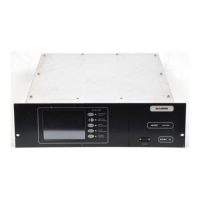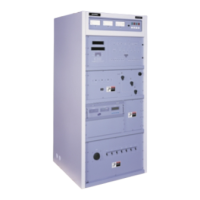tion by momentarily switching the fan breaker off while observ-
ing the air loss LED.
5.4 Cleaning
Use a vacuum cleaner as required to clean the cabinets. Be aware
of static discharge problems with the use of high velocity air in
dry climates when cleaning any circuit-board withstaticsensitive
components. A variety of static-safe vacuum equipment is avail-
able at most computer supply dealers.
A soft natural bristled paint brush with metal binding and wood
handle can beused to dislodge dust with minimum static genera-
tion. Hold the metal binding and touch a grounded surface to
discharge any difference in potential before working on the
board. Do not use nylon brushes with plastic handles.
Printed circuit board edge connectors may be cleaned using a
commercial cleaner such as Cramolin. Apply a small amount of
the cleaner to the contacts, then remove it with a clean, lint-free
cloth. Do not use a pencil eraser to clean contacts, as gold or
silver contact plating will be removed.
To clean motherboard sockets, wrap cloth around a small plastic
or metal card slightly thinner than the circuit boards. Apply a
small amount of the cleaner, and insert the cloth-covered card
into the connector. Reposition the cloth to a dry area to remove
the cleaner.
Inspect the RF amplifier module fins for accumulated dirt that
may have gone past the air filters. Remove using a brush and
vacuum.
Do not spray any liquids that may seep into the circuit board area.
Outside panel surfaces may be cleaned with a damp cloth using
water or mild household cleaners.
5.5 Fan Motor Currents
To measure fan motor current, use a remote clamp-on current
probe such as Fluke style B or C. Route its leads out through top
of cabinet. The gasket will compress around the leads when door
is shut.
Measure the cabinet intake blower currents. If an exhaust blower
is used, measure its currents as well.
Note the AC line voltage readings at this time as well, and record
the current and voltage data for future reference in Table 5-2.
As the motor bearings wear, the motor current may increase. A
periodic check will alert you to this change, indicating that
service is needed and preventing an untimely failure.
5.6 Motor Lubrication
The original blower has sealed, permanently lubricated bearings.
No routine service is required. In the event an alternate supplier
was used for motor replacement, check for grease fittings on the
motors. If found, lubricate motor annually using any of the
following:
• Shell “Dolium R”
• Chevron “SRI No 2”
• Texaco “Premium RB”
Excess grease can cause premature bearing failure. Do not allow
the grease to be contaminated. Turn the motor off and allow it to
stop rotating before greasing the bearings. Do not mix petroleum
and silicone grease.
5.7 Check Connections
WARNING
DISCONNECT ALL POWER TO TRANSMITTER BEFORE PER-
FORMING THE FOLLOWING STEP.
All wiring should be periodically checked for tight connections.
This is most important in the high-current circuits (cabinet AC
feed, AC breaker to DC powersupplies, power supply to DC bus,
DC bus to module connectors, etc.). Also check wires for lead
LINE VOLTAGES
A-B
B-C
A-C
CURRENTS
AURAL PA FAN MOTOR AURAL PA FAN MOTOR
AA
BB
CC
VISUAL PA A FAN MO-
TOR
VISUAL PA C FAN
MOTOR
AA
BB
CC
VISUAL PA B FAN MO-
TOR
VISUAL PA D FAN
MOTOR
A
B
C
INPUT BLOWER MOTOR EXHAUST BLOWER
MOTOR
AA
BB
CC
Table 5-2. Line Voltages and Currents
Section V - Maintenace
Rev. B: 1/11/1999 888-2365-001 5-3
WARNING: Disconnect primary power prior to servicing.
